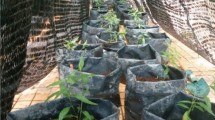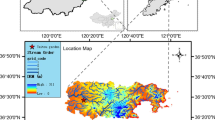Abstract
This study investigates the effects of radiation heat-load reduction under different shading conditions on the growth of three-year-old bayberry (Myrica rubra) trees from 1 July through 31 October 2007 in the Zhejiang Province, a warm subtropical region of China. The trees were grown under direct sunlight (control) and under 25%, 50%, and 75% shading conditions using black plastic nets. Stomatal conductance and photosynthesis were greatest under 50% shading, as were plant height and leaf and root dry weights. Twenty-five percent shading did not significantly influence plant height or root and leaf dry weights, whereas 75% shading resulted in a decrease in root and leaf dry weights when compared with the controls. The photochemical efficiency and electron transport of PSII increased under shaded conditions due to an increase in D1 protein. The concentrations of chlorophyll a and b and the total chlorophyll content in leaves were increased in plants grown under 25% and 50% shading, but reduced in those grown under 75% shading. Under 50% shading, growth and biomass increased due to increased photosynthesis, which resulted from decreased photodamage and increased chlorophyll concentration. These data show that 50% shading promotes optimal growth in bayberry plants.
Similar content being viewed by others
Literature Cited
Allakhverdiev SI, Kreslavski VD, Klimov VV, Los DA, Carpentier R, Mohanty P (2008) Heat stress: an overview of molecular responses in photosynthesis. Photosynth Res 98:541–550
Arnon DI (1949) Copper enzymes in isolated chloroplasts. Polyphenoloxidase in beta vulgaris. Plant Physiol 24:1–15
Bailey S, Horton P, Walters RG (2004) Acclimation of Arabidopsis thaliana to the light environment: the relationship between photosynthetic function and chloroplast composition. Planta 218:793–802
Barber J, Anderson B (1992) Too much of a good thing: light can be bad for photosynthesis. Trends Biochem Sci 17:61–66
Basu PS, Sharma A, Sukumaran NP (1998) Changes in net photosynthetic rate and chlorophyll fluorescence in potato leaves induced by water stress. Photosynthetica 35:13–19
Calcerrada JR, Pardos JA, Gil L, Reich PB, Aranda I (2008) Light response in seedlings of a temperate (Quercus petraea) and a sub-Mediterranean species (Quercus pyrenaica): contrasting ecological strategies as potential keys to regeneration performance in mixed marginal populations. Plant Ecol 195:273–285
Carmo-Silva AE, Salvucci ME (2012) The temperature response of CO2 assimilation, photochemical activities and Rubisco activation in Camelina sativa, a potential bioenergy crop with limited capacity for acclimation to heat stres. Planta 236:1433–1445
Chen ZL (1996) The history of bayberries. J Fruit Sci 13:59–61 [In Chin]
Chen K, Hu GQ, Lenz F (1997) Biomass partitioning in apple trees as affected by training, shading, and fruiting. Gartenbauwissenschaften 62:162–168
Cohen S, Moreshet S, Guillou LL, Simon JC, Cohen M (1997) Responses of citrus trees to modified radiation regime in semi-arid conditions. J Exp Bot 48:35–44
Demmig-Adams B, Adams WW, Winter K, Meyer A, Schreiber U, Pereira JS, Kruger A, Czygan FC, Lange OL (1989a) Photochemical efficiency of photosystem II, photon yield of O2 evolution, photosynthetic capacity, and carotenoid composition during the midday depression of net CO2 uptake in Arbutus unedo growing in Portugal. Planta 177:377–387
Demmig-Adams B, Winter K, Winkelmann E, Kruger A, Czygan FC (1989b) Photosynthetic characteristics and the ratios of chlorophyll, p-carotene, and the components of the xanthophyll cycle upon a sudden increase in growth light regime in several plant species. Bot Acta 102:319–325
Deng Y, Li C, Shao Q, Ye X, She J (2012) Differential responses of double petal and multi petal jasmine to shading: I. Photosynthetic characteristics and chloroplast ultrastructure. Plant Physiol Biochem 55:93–10
Farquhar GD, Caemmerer-Von S, Berry JA (1980) A biochemical model of photosynthetic CO2 assimilation in leaves of C3 species. Planta 149:78–90
Genty B, Briantais JM, Baker NR (1989) The relationship between the quantum yield of photosynthetic electron transport and quenching of chlorophyll fluorescence. Biochim Biophys Acta 990:87–92
Guo YP, Guo DP, Zhou HF, Hu MJ, Shen YG (2006a) Photoinhibition and xanthophyll cycle activity in bayberry (Myrica rubra) leaves induced by high irradiance. Photosynthetica 44:439–446
Guo YP, Zhou HF, Zhang LC (2006b) Photosynthetic characteristics and protective mechanismsagainst photooxidation during high temperature stress in two citrus species. Sci Hortic 108:260–267
Harley PC, Loreto E, Dimarco G, Sharkey TD (1992) Theoretical considerations when estimating the mesophyll conductance to CO2 flux by analysis of the response of photosynthesis to CO2. Plant Physiol 98:429–1436
Hideg É, Kós PB, Vass I (2007) Photosystem II damage induced by chemically generated singlet oxygen in tobacco leaves. Physiol Plant 131:33–40
Hu MJ, Guo YP, Shen YG, Guo DP, Li DY (2009) Midday depression of photosynthesis and effects of mist spray in citrus. Ann Appl Biol 154:143–155
Huang D, Wu L, Chen, JR, Dong L (2011) Morphological plasticity, photosynthesis and chlorophyll fluorescence of Athyrium pachyphlebium at different shade levels. Photosynthetica 49:611–618
Juurola E, Aalto T, Thum T, Vesala T, Hari P (2005) Temperature dependence of leaf-level CO2 fixation: revising biochemical coefficients through analysis of leaf three-dimensional structure. New Phytol 166:205–215
Krall JP, Edwards GE (1992) Relationship between photosystem II activity and CO2 fixation in leaves. Physiol Plant 86:180–187
Lambreva M, Stoyanova-Koleva D, Baldjiev G, Tsonev T (2005) Early acclimation changes in the photosynthetic apparatus of bean plants during short-term exposure to elevated CO2 concentration under high temperature and light intensity. Agric Ecosyst Environ 106: 219–232
Lei TT, Nilsen ET, Semones W (2006) Light environment under Rhododendron maximum thickets and estimated carbon gain of regenerating forest tree seed. Plant Ecol 184:143–156
Li L, Li XY, Xu XW (2014) Effects of high temperature on the chlorophyll a fluorescence of Alhagi sparsifolia at the southern Taklamakan Desert. Acta Physiol Plant 36:243–249
Liao JX, Wang GX (2014) Effects of drought stress on leaf gas exchange and chlorophyll fluorescence of Glycyrrhiza uralensis. Russian J Ecol 45:532–538
Maxwell K, Jonhson GN (2000) Chlorophyll fluorescence―a practical guide. J Exp Bot 51:659–668
Medina CL, Souza RP, Machado EC, Ribeiro RV, Silva JAB (2002) Photosynthetic response of citrus grown under reflective aluminized polypropylene shading nets. Sci Hortic 96:115–125
Mitchell RAC, Gibbard CL, Mitchell VJ, Lawlor DW (1996) Effects of shading in different developmental phases on biomass and grain yield of winter wheat at ambient and elevated CO2. Plant Cell Environ 19:615–21
Morandi B, Zibordi M, Losciale P, Manfrini L, Pierpaoli E, Grappadelli LC (2011) Shading decreases the growth rate of young apple fruit by reducing their phloem import. Sci Hortic 127:347–352
Müller P, Li XP, Niyogi KK (2001) Non-photochemical quenching, A response to excess light energy. Plant physiol 125:1558–556
Murata N, Takahashi S, Nishiyama Y, Allakhverdiev SI (2007) Photoinhibition of photosystem II under environmental stress. Biochim Biophys Acta 1767:414–421
Nash D, Miyao M, Murata N (1985) Heat inactivation of oxygen evolution in photosystem II particles and its acceleration by chloride depletion and exogenous manganese. Biochim Biophys Acta 807:127–133
Oh S, Koh SC (2014) Photosystem II photochemical efficiency and photosynthetic capacity in leaves of tea plant (Camellia sinensis L.) under winter stress in the field. Hortic Environ Biotechnol 55:363–371
Raschke K, Resemann A (1986) The midday depression of CO2 assimilation in leaves of Arbutus unedo L.: diurnal changes in photosynthetic capacity related to changes in temperature and humidity. Planta 168:546–558
Raveh E, Nerd A, Mizrahi Y (1998) Light adaptations of two cultivated hemi-epiphytic fruit cacti. Sci Hortic 73:151–164
Salvucci ME, Crafts-Brandner SJ (2004) Relationship between the heat tolerance of photosynthesis and the thermal stability of Rubisco activase in plants from contrasting thermal environments. Plant Physiol 134:1460–1470
Samarakoon AB, Wilson JR, Shelton H (1990) Growth, morphology and nutritive quality of shaded Stenotaphrum secundatum, Axonopus compressus and Pennisetum clandestinum. J Agric Sci 114:161–169
Schmid VHR, Thomé P, Rühle W, Paulsen H, Kühlbrandt W, Rogl H (2001) Chlorophyll b is involved in long-wavelength spectral properties of light-harvesting complexes LHCI and LHCII. FEBS Lett 499:27–31
Shirke PA, Pathre UV (2004) Modulation of Rubisco activity in leaves of Prosopis juliflora in response to tropical conditions in north India. Acta Physiol Plant 26:131–139
Sinha AK, Shirke PA, Pathre U, Sane PV (1997) Midday depression in photosynthesis: effect on sucrose-phosphate synthase and ribulose-1, 5-bisphosphate carboxylase in leaves of Prosopis juliflora (Swartz) DC. Photosynthetica 34:115–124
Stanhill G, Cohen S (2001) Global dimming: a review of the evidence for a widespread and significant reduction in global radiation with discussion of its probable causes and possible agricultural consequences. Agric For Meteorol 107:255–27
Syversten JP, Lloyd JJ (1994) Citrus. In Schaffer B, Andersen PC eds, Handbook of environmental physiology of fruit crops: Subtropical and tropical crops, CRC Press, Boca Raton, USA, pp 65–99
Takahashi S, Murata N (2008) How do environmental stresses accelerate photoinhibition? Trends Plant Sci 13:178–182
Takahashi S, Milward SE, Yamori W, Evans JR, Hillier W, Badger MR (2010) The solar action spectrum of photosystem II damage. Plant Physiol 153:988–993
Tozzi ES, Easlon HM, Richards JH (2013) Interactive effects of water, light and heat stress on photosynthesis in Fremont cottonwood. Plant Cell Environ 36:1423–1434
Ulqodry TZ, Matsumoto F, Okimoto Y, Nose A, Zheng SH (2014) Study on photosynthetic responses and chlorophyll fluorescence in Rhizophora mucronata seedlings under shade regimes. Acta Physiol Plant 36:1903–1917
Wang BP, Zheng YP, Li ZJ, Yu WW (2001) Utilization of Myrica rubra resources in Zhejiang and their ecological effects. J Zhejiang Forest Coll 18:155–160 [In Chin.]
Yakir D, Israeli Y (1995) Reduced solar irradiance effects on net primary productivity (NPP) and the 13C and 18O values in plantations of musa sp., Musaceae. Geochim Cosmochim Acta 59:2149–2151
Yang JC, Li M, Xie XZ (2013) Deficiency of phytochrome B alleviates chilling-induced photoinhibition in rice. Amer J Bot 100:1860–1870
Yu C, Huang SJ, Hu XM (2013) Changes in photosynthesis, chlorophyll fluorescence, and antioxidant enzymes of mulberry (Morus ssp.) in response to salinity and high-temperature stress. Biologia 68:404–413
Zhang LT, Li L, Liu JG (2014) Comparison of the photosynthetic characteristics of two Isochrysis galbana strains under high light. Bot Marina 57:477–481
Author information
Authors and Affiliations
Corresponding author
Rights and permissions
About this article
Cite this article
Zeng, G., Guo, Y., Xu, J. et al. Partial shade optimizes photosynthesis and growth in bayberry (Myrica rubra) trees. Hortic. Environ. Biotechnol. 58, 203–211 (2017). https://doi.org/10.1007/s13580-017-0003-x
Received:
Revised:
Accepted:
Published:
Issue Date:
DOI: https://doi.org/10.1007/s13580-017-0003-x




